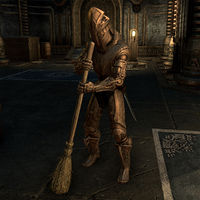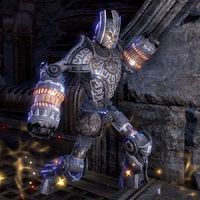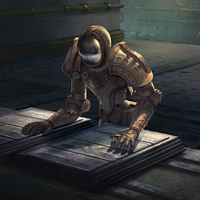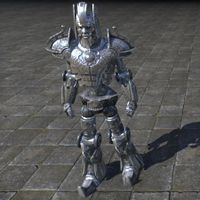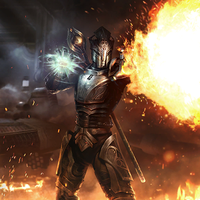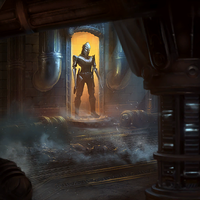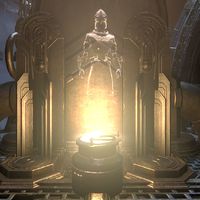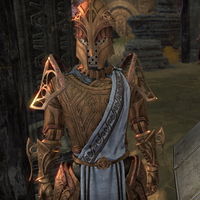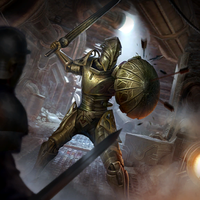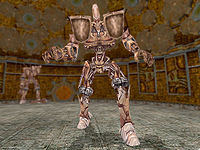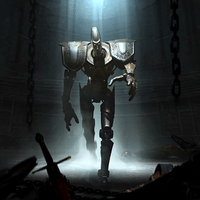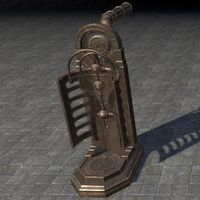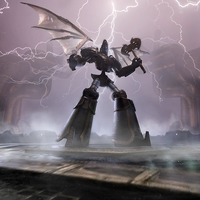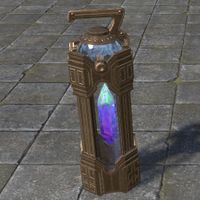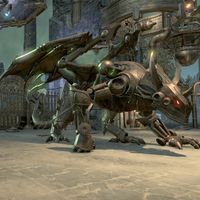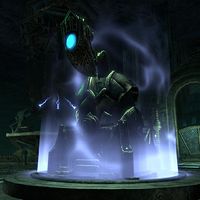Lore:Factotum
Factotums are mechanical constructs created by Sotha Sil, and said to serve as an extension of his divine will. An invention of need, they were created to maintain his great creation, the Clockwork City. As such, they have become an integral part of daily life for the inhabitants of the city, and are vital to running its everyday processes.[1][2]
Believed to be a fusion of brass and soul, factotums have a shared appearance, voice, and sense of purpose. They hold a structured intelligence, often centered on their singular function. Their dialogue and actions are all based on this function, with only the commonality of a devotion to the Clockwork God. Attempting to deviate from this purpose is simply incomprehensible to them.[1][3] The Factotum's very nature and materials informed the creation of the mechanical enhancements granted to Clockwork Apostles, resulting in a synthesis of flesh and engineering.[4]
Beloved by Sotha Sil, tinkering with or experimenting on factotums is considered a minor blasphemy and forbidden. As an extension of his divine will, Sotha Sil considers an attack on his factotums as an attack on him, and those who breach this law face severe sanction.[2]
Similar to factotums are the constructs known as fabricants, but they differ in that they are part organic, part inorganic, constructed from an amalgam of grown flesh and metallic grafts and are more bestial in appearance.
Characteristics[edit]
In order to maintain the Clockwork City, factotums performed all manner of jobs and tasks. Repair factotums kept factories and functions running. Guard factotums secured the locations of Sotha Sil's most dangerous secrets. Harvester factotums performed menial agricultural labor within the Everwound Wellspring. Cuisine Administrators prepared food. Some were even trusted enough to provide medical attention to the citizenry.[5] The Imperfect is a factotum designed with advanced combat features. A new prototype is created and is improved upon each time it is destroyed. Sequence plaques are collected to be analyzed for their data after each combat test so further advancements are made. One day it shall obtain its true form, and fulfill its ultimate goal.[6] An Apostle council known as the Congress of Calibration categorized the factotums of the Brass Fortress by their function, which resulted in numerous sub-groups being formed.[5] On occasion, Sotha Sil commanded his apostles to create a series of factotums for a specific purpose. One example was a series created to collect, analyze, and interpret social and environmental data. Using this data, Sotha Sil could accurately predict the trends and needs of Clockwork City's citizens and satisfy them before they ever realized they had any outstanding wants to gratify.[7]
The nature and creation of factotums was a closely guarded secret that has remained a mystery. Research on the constructs was typically met with opposition by the Clockwork Apostles.[1] To some, delving too deep into their subroutines and manufacture began to look less and less like inquiry, and more and more like hubris.[4] Factotums were created in the Pneumatic Forge—a vast, heavily guarded factory where not even the Apostles were allowed entry.[8][9] Factotums themselves were programmed to severely limit the amount of information they could give about themselves.[1] When faced with a query that required higher cognition, factotums often recited a non sequitur with no discernible connection to the larger conversation. Very rarely these non sequiturs (also known as "verbal artifacts") were expressed as troubling statements, which resulted in the factotum being recalled and taken out of circulation indefinitely.[4]
Despite their own mechanical enhancements being based on factotum technology, Clockwork Apostles were unable to replicate the intelligence Sotha Sil gave the factotum.[8] On occasion, mortal souls have successfully been transplanted into the body of a factotum, but inevitably led to the subject succumbing to insanity.[10][11]
History[edit]
Refabricants, The Early Factotums[edit]
Early model factotums are referred to as refabricants,[12] and were part of Sotha Sil's early efforts of taking Dwemeri design and making it his own. These proto-factotum's design bear a resemblance to Dwarven automatons and were constructed from both Dwarven and clockwork parts.[13][14]
The first factotum (and refabricant) Sotha Sil created was known as the Precursor, built sometime during the First Era and was heavily Dwemer influenced. However, unlike Dwemer automatons, the Precursor possessed a rudimentary form of artificial intelligence. Various crystals, known as Integrals, gave the Precursor the knowledge of mathematics, the ability to use logic and reason and even the ability for self reflection.[15] Over time the Dwarves became scorned by the Clockwork Apostles, and by extension their design aesthetic was also shunned. As a result Dwarven influences were removed from future factotum.[8][16] Clockwork holy texts commonly refer to the Precursor as the "Oscillating Son"—a fractured and discarded creation of Sotha Sil whose sole purpose was to convince unworthy Clockwork Apostles to rebuild him as a means to test their skills.[3]From the Precursor onward the factotum construct was continually refined and improved and early era Factotums would slowly lose their Dwemeri influences. Early generation factotums were designed from machine cogitation plates.[17] Sometimes it became necessary to create override devices in order to deal with design flaws (such as unintended aggression) but these became obsolete as factotum design evolved.[18]
Modern Factotums[edit]
By the mid-Second Era the factotum had reached its seventh incarnation, referred to as the Factotum series 7. It boasted numerous enhancements to ambulatory and reaction speed, coordination, facial recognition and vocabulary.[19] While the Precursor required a dynamo core as its power source, later factotum models required what was known as an animo core—a brass vessel that utilized a soul gem in some manner.[20][21][22] Although factotums share an identical voice, some apostles claim each unit expresses a unique personality.[5] The modern factotum's voice is also the subject of curiosity and speculation among some apostles. Most avoid the subject, but some will offer one of three major theories. Some believe the voice is that of Sotha Sil's mother. Others think it's the voice of a lost lover. Still others believe it's the voice of Sotha Sil's sister, Sotha Nall.[4]
The Clockwork City and its people, creatures, and constructs were still around in the Fourth Era. Circa 4E 201, a battle occurred between the Forgotten Hero and Mecinar, and the fate of the city and its inhabitants remains unknown. Some stories claim that the Forgotten Hero destroyed the Mechanical Heart that powered the Clockwork City, and its inhabitants were forced to abandon it as it ceased to function.[23] Another account holds that the hero used the Heart to harness its power and fought Mecinar on equal ground, allowing the Heart to live on along with the city.[24][25]
Notable Factotums[edit]
- AIOS — A master factotum created to maintain and supervise substrata operations of the Clockwork City
- The Precursor — The first factotum created by Sotha Sil in the First Era
- The Grand Prognosticator — An experimental factotum that acquired prophetic abilities
- The Steadfast Regulator — A factotum in charge of monitoring the sanitation process in the Halls of Regulation
- The Imperfect — A giant combat-enabled factotum
- Bolin — An apostle whose soul was transferred into the body of a Factotum, being driven insane by the conditions
- Proctor Sovor Saryoni — An apostle whose soul was transferred into the body of a Factotum
- Saint Felms the Bold — A former Temple Saint whose soul was transplanted into a factotum
- Saint Llothis the Pious — A former Temple Saint whose soul was transplanted into a factotum
- Saint Olms the Just — A former Temple Saint whose soul was transplanted into a Clockwork Titan, a factotum shaped like a Daedric Titan
Gallery[edit]
Notes[edit]
- Supposedly, a favorite pastime of bored Clockwork Apostle initiates was "factotum tipping", which involved overriding older factotum models' gyroscopes.[26]
- The Clockwork Titan is a construct that operates similarly to other Factotums. The only known Clockwork Titan housed the soul of Saint Olms.[27] It should not be confused with Clockwork Dragons,[28] whose exact origins are unknown. Soul gems that power the Clockwork Dragons don't belong to Dunmer saints. Apart from some shared design elements found in Sotha Sil's creations, there is no other known connection between them.[UOL 1]
See Also[edit]
- For game-specific information, see the Elder Scrolls Online
 and Legends articles.
and Legends articles.
Books[edit]
- The Mystery of Factotums by Associate Zanon, Clockwork Apostle — Scholarly notes pondering the mysteries of the Factotum
- The Factotum's Secret Voice by Lector Tidras Dran, Clockwork Apostle — A scholarly essay exploring the origins of the factotum's inner voice
- Factotum Classification - Log 233 by Proctor Neimos, Apostle of Sotha Sil — A description of each factotum subgroup found in the Clockwork City
References[edit]
- ^ a b c d The Mystery of Factotums — Associate Zanon, Clockwork Apostle
- ^ a b Sotha Sil's dialogue in ESO: Clockwork City
- ^ a b Lector Trivura's dialogue in ESO
- ^ a b c d The Factotum's Secret Voice — Lector Tidras Dran, Clockwork Apostle
- ^ a b c Factotum Classification - Log 233 — Proctor Neimos, Apostle of Sotha Sil
- ^ Clockwork Facilitator's dialogue in ESO: Clockwork City
- ^ Thoughts of the Honored Assistant
- ^ a b c Associate Zanon's dialogue in ESO
- ^ Divayth Fyr's dialogue in ESO
- ^ Most Complicated Machine quest in ESO
- ^ Saints' Mercy quest in ESO
- ^ Refabricant Slayer achievement description in ESO
- ^ The Precursor's dialogue in ESO
- ^ Crafting Motif 79: Refabricated Style — Dreyla Indavel, Halls of Fabrication
- ^ Construct's Integral of Calculus, Introspection and Reason items in ESO
- ^ The Precursor quest in ESO
- ^ Vintage Factotum Fabrication Orders contraband item in ESO
- ^ Outdated Factotum Override contraband item in ESO
- ^ Factotum Model Registry
- ^ Imperfect Operations Manual
- ^ Construct's Dynamo Core item in ESO
- ^ Energetic Animo Core furnishing item in ESO
- ^ The City Falls in Return to Clockwork City
- ^ Journey's End in Return to Clockwork City
- ^ Events of Return to Clockwork City
- ^ Manual of Factotum Tipping contraband item in ESO
- ^ Saint Olms the Just in ESO
- ^ Clockwork Dragon in Legends
Note: The following references are considered to be unofficial sources. They are included to round off this article and may not be authoritative or conclusive.
|
|||||||||||||||||||||||||||||||||||||||||||
